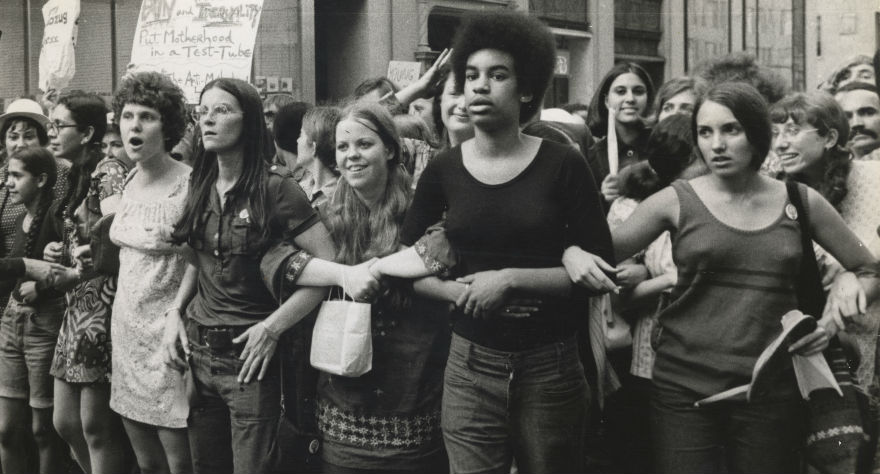
Dore's blistering portrait of the Women's Liberation Movement is as entertaining as it is educational.

Dore's blistering portrait of the Women's Liberation Movement is as entertaining as it is educational.
Mary Dore’s portrait of the Women’s Liberation Movement, She’s Beautiful When She’s Angry, is blistering, informative, and wildly entertaining. But the most jaw-dropping thing about the film is that it’s somehow the very first of its kind; never before has the women’s movement been the subject of a feature documentary. It’s frankly upsetting that this is the case, but now is as good a time as ever for a crucial film like this to hit theaters and classrooms across the country. The film combines interviews with myriad key figures of the movement with a wealth of the damnedest archival footage you’ll see, and it’s both an essential document of the movement and a wildly entertaining 90-minute tribute to some of America’s greatest unsung heroes.
The tragedy of She’s Beautiful is in line with the tragedy of Ava DuVernay’s Selma, which is to say that the issues its activists combated are still as relevant today as they were back then. The film focuses on pivotal events between 1966 and 1971, a time when women were mostly viewed and depicted as subservient homemakers, inferior members of the workforce, or even fanatical, mindless sheep, stricken with the fever that was Beatlemania.
Raging against these dehumanizing stereotypes were intrepid individuals and the groups to which they belonged, from the National Organization of Women (NOW), to Betty Friedan and her seminal book “The Feminine Mystique”, to the New Left movement, to Chicago’s Jane Collective, an awe-inspiring organization that performed over 11,000 safe, affordable abortions for women for years until Roe vs. Wade made abortions legal. Also covered is the imminently influential book “Our Bodies, Ourselves”, produced by the Boston Women’s Health Book Collective. Dore recounts a staggering number significant figures, works, and events of the time, and on top of that conducts interviews with several drivers of the movement, including Judith Arcana, Roxanne Dunbar-Ortiz, Ellen Willis, Fran Beal, Ruth Rosen, and many others.
This is an extremely expansive, richly informative film, but it won’t make your head spin. The images Dore and her team dig up are so striking and rarely seen (again, the women’s movement has been woefully neglected in the classroom and in media) that everything seems to stick in the mind, with very little flying under the radar. When you see images of women dressed in witch costumes, casting hexes on male politicians as a part of the Women’s International Terrorist Conspiracy from Hell (W.I.T.C.H.), however brief the glimpse, it’s something you’ll never forget. That so much of the information resonates is a testament to both the archival team’s treasure-hunting skills and Dore and the editors’ (Nancy Kennedy, Kate Taverna) ability to assemble the insane number of clips and interviews into an easily digestible piece of history filmmaking. For some, the sheer abundance of content may be overwhelming or hard to keep track of, but the keen organization of it all helps to mitigate info-overload.
Unlike many history docs about other, similarly significant campaigns, like the anti-war movement and the civil rights movement, She’s Beautiful isn’t a chore to watch. Far from it: much like the movement it represents, the film is eccentric, funny, brazen, scandalous, and totally unapologetic. Dore, who’s worked on archival films for years, knows how to arrange the material in a way that feels energetic, immediate, and carries a sense of constant locomotion.
The most illuminating facet of the film is how it delves into the complexities and incongruities within the movement. Each group under the larger women’s liberation umbrella had separate, sometimes contradictory stances on a variety issues (race, abortion, sexuality), and the forced idea of all women standing together in monolithic formation was an impractical one, and was arguably the biggest flaw in the campaign. The most poignant truth Dore sheds light on is that the movement was flawed because it was made up of Americans, and at the time, America was an incredibly flawed country (though it’s still miles from perfect today).
Some of the most shocking moments come in the form of archival news clips in which men express their insipid views on the role of women. “The girls, I think, have got it over the guys. They get everything paid for…I don’t see what they’re arguing about,” says an everyday businessman being interviewed at a women’s rights rally. The battiest quote comes from a male newscaster who spouts this garbage in reaction to a women’s strike: “Remember, men: If you come to work tomorrow and your secretary refuses to do the filing, and then go home and find that your wife refuses to do the cooking, don’t blame them. Remember, you gave them the vote 50 years ago.” Clips like these are a bitter reminder of just how deluded and ugly the social consciousness can become without strong activists to slap some sense into those who would subscribe to such malarky.
Without the women’s movement, the world would be an uglier, crueler place, and a film like She’s Beautiful When She’s Angry should have been made way earlier than 2015, but we’re incredibly lucky to have it today. It’s a well-organized, provocative, absorbing film with real attitude, and Dore’s uncompromising presentation will hopefully help it make an impact in both educational circles and at the box office.